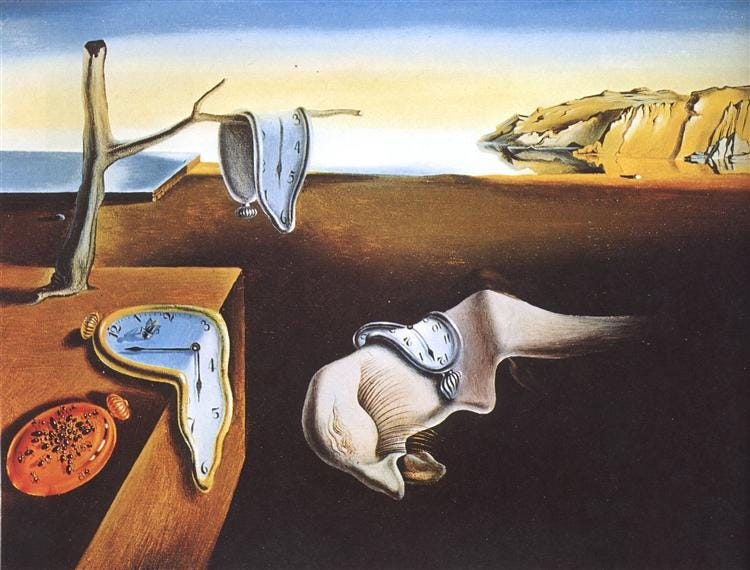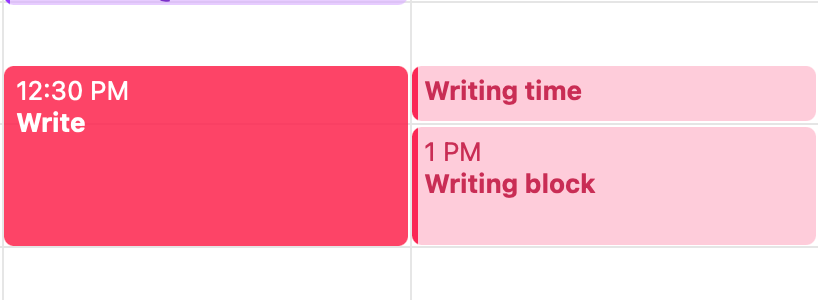How to Find Time to Write
5 ways to make time your friend and produce the excellent work you know you can

Not enough time.
That’s what many Substack writers and many of my clients say when asked why they don’t write as much as they wish they did or keep to a regular publishing cadence.
Writing Substack posts your subscribers actually read, engage with, and pay for takes time. It’s what makes a Substack grow and be profitable.
But how to find the time?
Below, I give you five ways to make your calendar your friend and produce the excellent work you know is inside you:
Don’t get lost on Notes
Time block
Tell yourself what to do
Understand that a task will take as long as you decide it will
Strategize on Sundays

1. Don’t get lost on Notes
Substack’s Notes is both helpful for growth and a time sucker.
Ultimately, Notes is Substack’s internal social media network and is like any other social media platform. It can produce that oh-so-familiar social-media feeling of inadequacy and the belief that we need to be on there all the time, which takes you away from your Substack, which is the only thing that will actually help you grow and earn an income (if that’s what you’re interested in.)
For some, Notes is extremely unpleasant.
For others, it’s an amazing way to connect with and discover other Substacks.
It can be fun.
Don’t overcomplicate Notes. Just follow these twelve Notes templates or keep it even simpler with these five. Also, Hamish McKenzie’s classic conversation with
.What you do on Notes should be in line with you and your particular Substack. Here’s a way to discover what your Notes might look like:
Sit down and look at your About page. Your About page should tell you and your potential subscribers exactly what your Substack is. Those are the topics of your posts on Notes. (Plus, pet pictures.) Substack Writers at Work is about helping writers master the art and business of using Substack to become a better writer and succeed in your career. Nearly all of my posts are about that—or highlighting other writers. (Plus, pet pictures.)
You can restack other people’s Notes, other people’s posts, and (always) your own posts.
I suggest spending time on the Notes comments that share your topic or category—interact with those responding to posts who aren’t getting a response from the Substacker simply because the Substacker doesn’t have (yup) time to respond to all of them.
There’s much more to say about Notes, but the main thing is to use it wisely or not at all.
Notes is optional. Ultimately, it is social media.
If you find yourself on Notes more than on writing your own posts, set aside a particular amount of time, set a timer, and stick to it, which is a Herculean effort given that it’s designed to keep us on there scrolling, scrolling, scrolling.
If that doesn’t work, remove the app from your phone.
2. Time block
Cal Newport, a computer science professor and researcher at Georgetown, isn’t the first or only person to bring us the concept of time blocking, but he’s the king. He’s a philosopher on how to work well in the digital age. To him—and many people, myself included—time blocking is key to making deep work happen.
Time blocking entails scheduling every minute of your workweek (or week). You block out 9 to 11 to write your novel, 11 to 12 to walk, 12 to 1 to each lunch and answer email, 1 to 2 to write your next blog post, etc. It’s magical. It
eliminates that maddening confusion when you spin on what to do next (Write my novel? Change the sheets? Pet the cats?),
allows you to fully focus (particularly during time blocks that Newport calls deep work), and
helps you relax and enjoy writing because you know everything is scheduled and will get done.
3. Tell yourself what to do
When I finally started keeping a calendar, it looked like some variation of this:
It took me too long to learn to give myself detailed instructions on what to do during each time block.
We need clear directions. Be specific: 11-12 Complete a fast, messy, “shitty first draft” of post for 11/20 (thank you,
), 12-1 Eat lunch and zero out inbox, 1-2 Revise 11/20 post.Plus, this gets the brain working in advance. Give your brain a sense of where you want to go, and it will start to noodle out the particulars while you sleep.
4. A task will take as much time as you give it
If you say you’ll finish a chapter in four days, it will take four days. If you say you’ll finish it in one day, you will.
There are limits, of course. A chapter that requires twelve hours of work (according to how quickly you write) likely won’t be completed in two hours. But within reason, the time you block off to complete a task is the time it will take.
If you’re telling yourself, I can’t do that. Things are always coming up unexpectedly. Unless someone is bleeding, very few things need to be done immediately. If you still think it’s impossible, Cal Newport has the answer: block off periods of open-ended reactivity time.
5. Strategize on Sundays
Put aside half an hour on Sundays to time-block your entire week. Look at what you want to finish writing that week (a chapter, a section, two posts, etc.) and schedule accordingly.
You can’t always be ultra-specific on Sunday because you don’t always know where you’ll be in the process on Thursday or Friday. If you prefer, fill in the specifics the day before. Cal Newport calendars his week generally and then spends twenty minutes every evening scheduling the next work day.
Not all of this will work for you. Try what you haven’t tried before. Time is of your own making.
Ultimately, what makes most Substacks grow and be profitable is great writing. (Substack’s original tagline was “the home for great writing.”)
But “great writing” isn’t what many think it is.
“Great writing” on Substack is neither literary nor “online writing.” It doesn’t involve having AI write your posts for you. It takes into account the fact that we’re writing in two genres—the blog and the newsletter. (I’m trying to coin the genre and am open to suggestions in the comments: nlog? bletter?)
It comes from mastering five craft elements available to any Substack writer, whether you think of yourself as “a writer” or not: voice, storytelling, humor (!), edge, and processes.
Great writing requires time, but the kind of time that’s meditative, unhurried, fulfilling, calming, centering, etc., etc. For many of you, that’s what you came here to do—or at least explore.
I’ll be guiding Substack writers through this in my course, The Craft of Writing on Substack: How to write a Substack people read, engage with, and pay for, beginning October 24—the same curriculum I teach at Northwestern, without you having to pay $23k or get a 1560 on your SATs to take it.





Thanks so much for the comment about the conversation with Hamish about the launch of "Notes." I find I am able to gain new readers and subscribers more effectively than anything else by offering readers pieces of writing, not advice about writing. I don't restrict who can read and comment on my "Notes" or stack posts. I don't have a paywall, and by welcoming new readers with an interest in literary narrative, I've grown my stack to 16,000 subscribers in a little more than three years.
My problem is not not writing enough but allowing myself to write more.